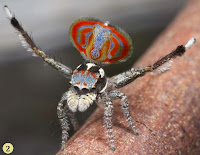Harvestmen, Opiliones,
are carnivorous Arachnids resembling Spiders, though they are not
closely related and are incapable of producing silk. They are found
across the globe, but reach their maximum diversity in the tropics of
Central and South America. The genus Iandumoema currently
contains two species from cave systems in northern Minas Gerais
State, Brazil. Iandumoema setimapocu
is found in a single cave in the municipality of Coração de Jesus,
while Iandumoema uai is
found in two caves in the municipality of Itacarambi.
In
a paper published in the journal ZooKeys on 18 November 2015, RicardoPinto-da-Rocha of the Departamento de Zoologia at the Universidade de São Paulo, Rafael da
Fonseca-Ferreira of the Departamento de Ecologia e Biologia Evolutiva
at the Universidade Federal de São Carlos and the Programa dePós-graduação em Biologia Comparada at the Universidade de São
Paulo, and Maria Elina Bichuette, also of the Departamento de
Ecologia e Biologia Evolutiva at the Universidade Federal de São
Carlos, describe a new species of Iandumoema
from two caves in the Monjolos Region of Minas Gerais State.
The
new species is named Iandumoema smeagol,
in reference to the cave dwelling creature Gollum/Smeagle from the
writings of JRR Tolkein. It is an entirely cave-dwelling species,
lacking in pigmentation and, unlike the previously described species
in the genus, having completely lost its eyes.
Iandumoema smeagol,
male specimen in right lateral view. Pinto-da-Rocha et al.
(2015).
Iandumoema smeagol
is known only from two caves, both within limestone rocks of the
Bambuí Group at the edge of the Serra do Espinhaço Plateau.
These caves are home to a large Bat colony, with extensive guano
deposits that support a diverse assemblage of invertebrates. This
population presumably provides a food source for the Harvestmen,
though none was ever seen to approach the guano deposits.
Iandumoema smeagol
has a known geographical distribution of 4.6 km2,
which is fairly typical for a cave-dwelling invertebrate species,
which tend to have high levels of endemism (very limited
distributions). The area where it was found enjoys no legal
protection, and deforestation and limestone extraction, as well as
possible future hydroelectric projects, present a potential threat to
the survival of the species. For this reason Pinto-da-Rocha et
al. recommend that Iandumoema
smeagol be regarded as
Vulnerable under the terms of the International Union for the Conservation of Nature's Red List of Threatened Species, and an
effective conservation plan be developed to protect the area.
See
also...
 Tityus apozonalli: A new species of Scorpion from Miocene Chiapas Amber. The ambers of Chiapas State,
Mexico, were laid down in the Miocene (and possibly Oligocene) in shallow
marine environments. The amber is thought to be derived from resin secreted
from a Leguminous tree of the genus Hymenaea,
which lived in mangrove...
Tityus apozonalli: A new species of Scorpion from Miocene Chiapas Amber. The ambers of Chiapas State,
Mexico, were laid down in the Miocene (and possibly Oligocene) in shallow
marine environments. The amber is thought to be derived from resin secreted
from a Leguminous tree of the genus Hymenaea,
which lived in mangrove... Maratus elephans, a new species of Peacock Spider from New South Wales. Peacock Spiders of the genus Maratus are a group of Jumping Spiders, Salticidae,
found only in Australia. They are small in size, typically less than 5 mm in
length, though the males are brightly coloured and engage in elaborate
courtship dances, which give...
Maratus elephans, a new species of Peacock Spider from New South Wales. Peacock Spiders of the genus Maratus are a group of Jumping Spiders, Salticidae,
found only in Australia. They are small in size, typically less than 5 mm in
length, though the males are brightly coloured and engage in elaborate
courtship dances, which give... A new species of Ixodid Tick from southern Brazil. Ixodid Ticks of the genus Amblyommaare parasites of Mammals found on all continents except Europe and Antarctica,
but at their most diverse in South America, with 31 species described from
Brazil alone (46% of all known Tick species from Brazil). These Ticks...
A new species of Ixodid Tick from southern Brazil. Ixodid Ticks of the genus Amblyommaare parasites of Mammals found on all continents except Europe and Antarctica,
but at their most diverse in South America, with 31 species described from
Brazil alone (46% of all known Tick species from Brazil). These Ticks...
Follow Sciency Thoughts on Facebook.

